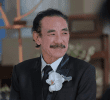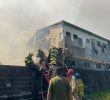Bankerohan and the other public markets in Davao are places to explore, not only for fun but for a few pesos of savings in this increasingly difficult times.
By Daisy C. Gonzales
davaotoday.com
DAVAO CITY — If you are a first-timer here — if, let’s say, you don’t have any idea about this city except its tough-talking mayor, the beaches, the white sand — try visiting the public markets, where you will discover this metropolis’s naked allure.
Try it — and you will find the ingenuity of a people trying to eke out a living, the prices that are lower compared to those in air-conditioned malls, the luscious fruits on the stands, the fresh flowers lining up the sidewalks, greeting you with their warmth.
Don’t mind the filth and the odor. After your visit, just wash it off with Davao’s finest water and all that will be left is the insight – not to mention the savings — you gained.
This city has about seven major public markets; many small ones dot the city corners, mostly near lower-class subdivisions or near the city’s seaside. The bigger ones are located at the heart of each district and near the source of the goods. In the outskirts, for instance, in the southwest, vegetable farmers sell their produce at the Calinan Public Market, while in the north, not far from the coastline of Davao, fisherfolk bring their fresh catch to the Sasa Public Market.
The three bigger public markets – the ones in Agdao, Toril and Bankerohan — are right in the urban centers. The biggest is Bankerohan, which is itself a “landmark” of the city, says its officer-in-charge, Joseph Fernandez.
Since it’s the biggest, Bankerohan is also the main trading post for goods and produce from as far away as the cities of Kidapawan (for its vegetables) and General Santos (for its fishes).
The fish cars arrive in Bankerohan as early as 2 a.m., says Loloy, a twentysomething fish-car helper. Then the frantic sorting of the fishes and the deliveries start. The fish cars are emptied before light breaks in the east. Workers like Loloy take a leisurely breakfast and then see to it that the fish baskets are accounted for and the fish cars are clean. Loloy’s rest comes only when the fish cars take to the road again for the three-hour trip back to General Santos City.
Anywhere else in the market, even in the wee hours, carinderias or eateries serve instant coffee. Up on the second floor of the wet section, on the other hand, stalls upon stalls offer affordable and deliciously hot bulalo served in generous servings. It is as good for an empty stomach as it is for those nursing a hangover.

A vegetable vendor in Bankerohan. (Photo by Barry Ohaylan )
By 4 a.m., you might be tempted to venture to the other side of the market. But don’t cross the street yet. Take the underpass instead. In one of the shanties near the bridge lives 58-year-old Nong Berto and his family. All of them are already on their feet at this hour. Nong Berto buys and sells anything. He buys from people scraps that usually come from the garbage – containers, wine bottles, spoons, forks, to name a few. He cleans what he would sell and displays these outside his shanty, along with other sellers. At day’s end, he says, the money he makes from scraps is not enough but it would help bring food to his family’s table.
Some meters away from Nong Berto’s place is the vegetable bagsakan . Trading begins in the early morning for only two hours; it opens again for five hours late in the afternoon. Cheap and fresh vegetables are displayed in the sidewalks during these hours.

Stuff can be bought from the many vendors near and under the overpass in Bankerohan.(Photo by Barry Ohaylan – davaotoday.com).
People also get busy bargain hunting, digging into piles upon piles of ukay-ukay (used) clothes near the overpass. In these piles, you can actually find something nice at 1.50 pesos. Just be sure to be there early or you will miss a good buy.
Or you can try those stalls inside Bankerohan, where you might find good souvenir items, from wooden ladles, spoons, forks to vintage kerosene lamps, as well as Davao’s famous malong or banig . Here, the prices for these items are much cheaper than in souvenir shops near hotels.

The approach to Bankerohan. (Photo by Barry Ohaylan – davaotoday.com)
Compared to the shopping malls in the city, prices at Bankerohan – for meat and fish, for example – are 20 to 30 percent cheaper, says Fernandez, the market official. In 2001, average sales in Bankerohan every day was 2 million pesos; during paydays, the sales could go as high as 5 million pesos.
Cleanliness and order are a concern in the one-hectare public market, which accumulates more garbage than any of the other public markets. Petty crimes are common.
Bankerohan and the other public markets in Davao are places to explore, not only for fun but for a few pesos of savings in this increasingly difficult times. (Daisy C. Gonzales/davaotoday.com)
Food









